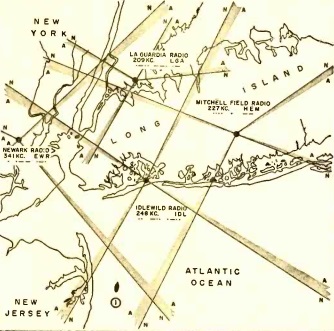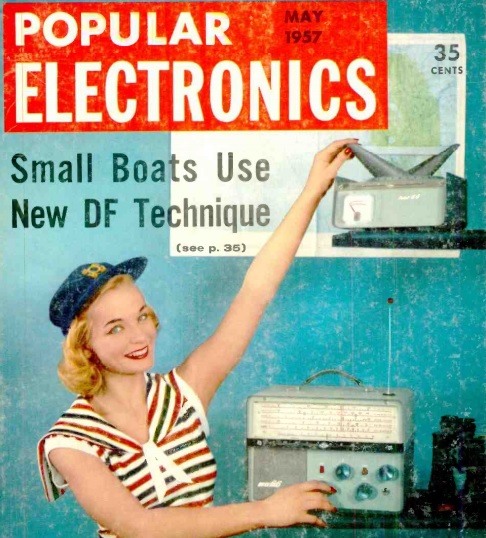The mariner shown here 60 years ago on the cover of the May 1957 issue of Popular Electronics is demonstrating two methods of radio navigation described in the magazine, using a National NC-66 receiver and its optional external loop antenna.
Using the receiver alone, she is using the method that required no special direction finding antenna, and that provided accurate results even in a small bouncing boat.
That method used the “A-N” longwave radio ranges which were still operating between 200-400 kHz. While these aeronautical radio ranges were most often used by pilots, there was no reason why they couldn’t be used by boaters, as long as the craft had a longwave receiver aboard.
As we described in an earlier post, each of these beacons transmitted two signals in a four-leaf clover pattern. In two quadrants, the Morse letter A (dot-dash) could be heard. In the other two quadrants, the letter N (dash-dot) could be heard. At the intersections of the two signals (“on the beam” normally followed by pilots), the signals would merge and be continuous.
 For example, a boater shown at the position marked 1 near the bottom of this map would first tune to 227 kHz to beacon HEM at Mitchell Field, Long Island. She would hear the A. Then, she would tune to 248 to listen to the beacon IDL at Idlewild and hear the N. Finally, she could tune in EWR Newark on 341 kHz, where N would be heard.
For example, a boater shown at the position marked 1 near the bottom of this map would first tune to 227 kHz to beacon HEM at Mitchell Field, Long Island. She would hear the A. Then, she would tune to 248 to listen to the beacon IDL at Idlewild and hear the N. Finally, she could tune in EWR Newark on 341 kHz, where N would be heard.
By consulting the chart and using the process of elimination, this would narrow her location down to the relatively small quadrangle off the New Jersey coast.
The magazine also described the next logical step in navigation skill as use of the optional loop antenna and null meter shown at the top of the picture. As we’ve described previously, such an antenna would allow an exact bearing to any station, using either a marine beacon or standard AM broadcast station.


Pingback: 1968 Marine Receiver | OneTubeRadio.com